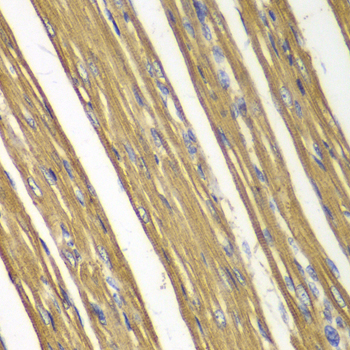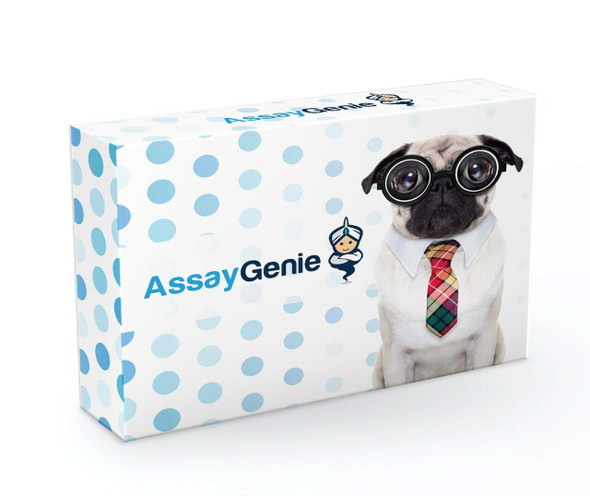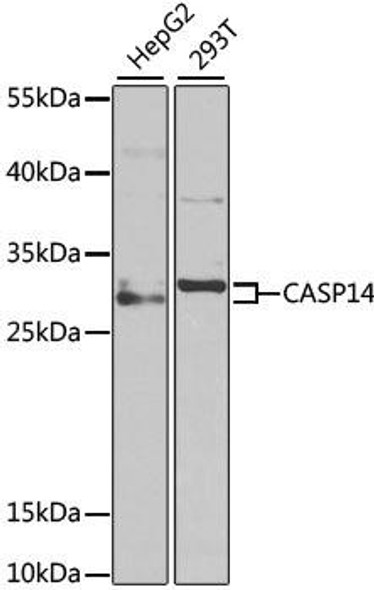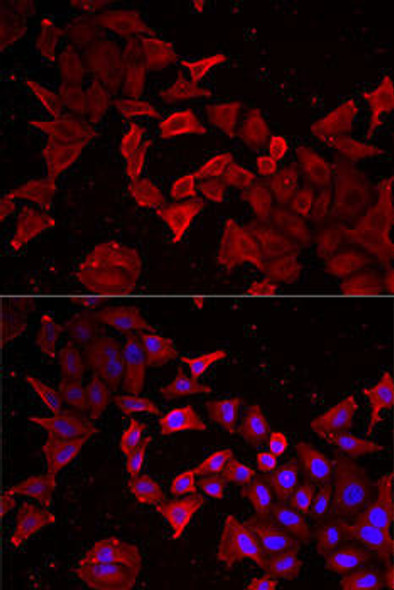Description
Anti-Caspase-7 Antibody (CAB0716)
The Caspase 7 Polyclonal Antibody (CAB0716) is a valuable tool for researchers studying caspase 7, an important enzyme involved in cellular apoptosis. This antibody, produced in rabbits, exhibits high reactivity with human samples and has been validated for use in Western blot applications. By specifically binding to caspase 7 protein, this antibody enables precise detection and analysis in a variety of cell types, making it ideal for investigations in the fields of cell biology and cancer research.Caspase 7 plays a crucial role in programmed cell death, also known as apoptosis, by cleaving specific protein targets and initiating the cascade of events that lead to cell demise.
Dysregulation of caspase 7 activity has been implicated in various diseases, including cancer and neurodegenerative disorders, making it a key target for therapeutic intervention. By studying the function of caspase 7 using this antibody, researchers can uncover new insights into the mechanisms of apoptosis and potentially identify novel treatment strategies for related pathologies.
| Antibody Name: | Anti-Caspase-7 Antibody |
| Antibody SKU: | CAB0716 |
| Antibody Size: | 20uL, 50uL, 100uL |
| Application: | IHC IP |
| Reactivity: | Human, Rat |
| Host Species: | Rabbit |
| Immunogen: | Recombinant fusion protein containing a sequence corresponding to amino acids 24-303 of human Caspase-7 (NP_001218.1). |
| Application: | IHC IP |
| Recommended Dilution: | IHC 1:50 - 1:100 IP 1:50 - 1:100 |
| Reactivity: | Human, Rat |
| Positive Samples: |
| Immunogen: | Recombinant fusion protein containing a sequence corresponding to amino acids 24-303 of human Caspase-7 (NP_001218.1). |
| Purification Method: | Affinity purification |
| Storage Buffer: | Store at -20'C. Avoid freeze / thaw cycles. Buffer: PBS with 0.02% sodium azide, 50% glycerol, pH7.3. |
| Isotype: | IgG |
| Sequence: | AKPD RSSF VPSL FSKK KKNV TMRS IKTT RDRV PTYQ YNMN FEKL GKCI IINN KNFD KVTG MGVR NGTD KDAE ALFK CFRS LGFD VIVY NDCS CAKM QDLL KKAS EEDH TNAA CFAC ILLS HGEE NVIY GKDG VTPI KDLT AHFR GDRC KTLL EKPK LFFI QACR GTEL DDGI QADS GPIN DTDA NPRY KIPV EADF LFAY STVP GYYS WRSP GRGS WFVQ ALCS ILEE HGKD LEIM QILT RVND RVAR HFES QSDD PHFH EKKQ IPCV VSML TKEL YFSQ |
| Gene ID: | 840 |
| Uniprot: | P55210 |
| Cellular Location: | Cytoplasm |
| Calculated MW: | 28kDa/31kDa/34kDa/37kDa |
| Observed MW: | Refer to figures |
| Synonyms: | CASP7, CASP-7, CMH-1, ICE-LAP3, LICE2, MCH3, caspase-7, Casp7 |
| Background: | This gene encodes a member of the cysteine-aspartic acid protease (caspase) family. Sequential activation of caspases plays a central role in the execution-phase of cell apoptosis. Caspases exist as inactive proenzymes which undergo proteolytic processing at conserved aspartic residues to produce two subunits, large and small, that dimerize to form the active enzyme. The precursor of the encoded protein is cleaved by caspase 3 and 10, is activated upon cell death stimuli and induces apoptosis. Alternatively spliced transcript variants encoding multiple isoforms have been observed for this gene. |
| UniProt Protein Function: | CASP7: Involved in the activation cascade of caspases responsible for apoptosis execution. Cleaves and activates sterol regulatory element binding proteins (SREBPs). Proteolytically cleaves poly(ADP-ribose) polymerase (PARP) at a '216-Asp-|-Gly- 217' bond. Overexpression promotes programmed cell death. Heterotetramer that consists of two anti-parallel arranged heterodimers, each one formed by a 20 kDa (p20) and a 11 kDa (p11) subunit. Interacts with BIRC6/bruce. Highly expressed in lung, skeletal muscle, liver, kidney, spleen and heart, and moderately in testis. No expression in the brain. Inhibited by isatin sulfonamides. Belongs to the peptidase C14A family. 3 isoforms of the human protein are produced by alternative splicing. |
| UniProt Protein Details: | Protein type:Apoptosis; EC 3.4.22.60; Endoplasmic reticulum; Protease; Mitochondrial Chromosomal Location of Human Ortholog: 10q25 Cellular Component: nucleoplasm; cytoplasm; nucleus; cytosol Molecular Function:protein binding; cysteine-type endopeptidase activity; cysteine-type peptidase activity Biological Process: apoptosis; caspase activation via cytochrome c; proteolysis; cell structure disassembly during apoptosis |
| NCBI Summary: | This gene encodes a member of the cysteine-aspartic acid protease (caspase) family. Sequential activation of caspases plays a central role in the execution-phase of cell apoptosis. Caspases exist as inactive proenzymes which undergo proteolytic processing at conserved aspartic residues to produce two subunits, large and small, that dimerize to form the active enzyme. The precursor of the encoded protein is cleaved by caspase 3 and 10, is activated upon cell death stimuli and induces apoptosis. Alternatively spliced transcript variants encoding multiple isoforms have been observed for this gene. [provided by RefSeq, May 2012] |
| UniProt Code: | P55210 |
| NCBI GenInfo Identifier: | 1730092 |
| NCBI Gene ID: | 840 |
| NCBI Accession: | P55210.1 |
| UniProt Secondary Accession: | P55210,Q13364, Q53YD5, Q5SVL0, Q5SVL3, Q96BA0, B4DQU7 B5BU45, D3DRB8, |
| UniProt Related Accession: | P55210 |
| Molecular Weight: | 31,614 Da |
| NCBI Full Name: | Caspase-7 |
| NCBI Synonym Full Names: | caspase 7, apoptosis-related cysteine peptidase |
| NCBI Official Symbol: | CASP7 |
| NCBI Official Synonym Symbols: | MCH3; CMH-1; LICE2; CASP-7; ICE-LAP3 |
| NCBI Protein Information: | caspase-7; apoptotic protease MCH-3; ICE-like apoptotic protease 3; caspase 7, apoptosis-related cysteine protease |
| UniProt Protein Name: | Caspase-7 |
| UniProt Synonym Protein Names: | Apoptotic protease Mch-3; CMH-1; ICE-like apoptotic protease 3; ICE-LAP3 |
| Protein Family: | Caspase |
| UniProt Gene Name: | CASP7 |
| UniProt Entry Name: | CASP7_HUMAN |
 | Immunohistochemistry of paraffin-embedded rat heart using Caspase-7 antibody (CAB0716) at dilution of 1:100 (40x lens). |








